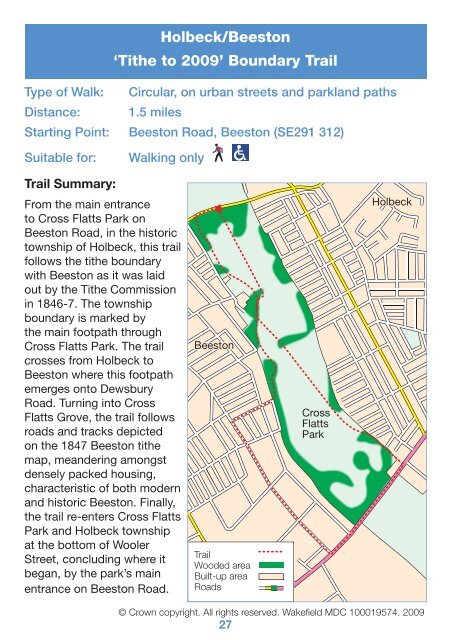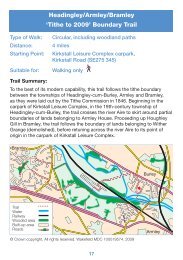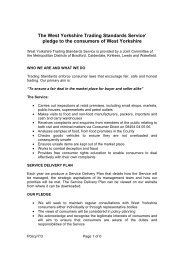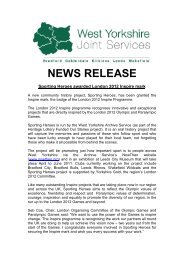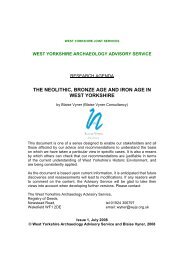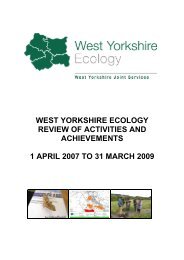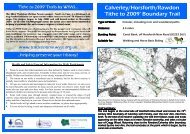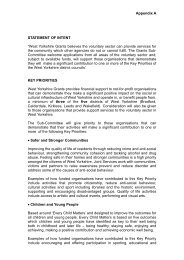Holbeck (Beeston) - Tracks in Time, the Leeds Tithe Map Project
Holbeck (Beeston) - Tracks in Time, the Leeds Tithe Map Project
Holbeck (Beeston) - Tracks in Time, the Leeds Tithe Map Project
You also want an ePaper? Increase the reach of your titles
YUMPU automatically turns print PDFs into web optimized ePapers that Google loves.
or abbey <strong>in</strong> <strong>the</strong> middle ages. There are certa<strong>in</strong>ly records of <strong>the</strong> Manor of<strong>Beeston</strong> be<strong>in</strong>g gifted to <strong>the</strong> Cistercian monks at Kirkstall Abbey <strong>in</strong> <strong>the</strong> 12thcentury. The rema<strong>in</strong><strong>in</strong>g agricultural build<strong>in</strong>gs here certa<strong>in</strong>ly predate <strong>the</strong> 1846ti<strong>the</strong> map. Although <strong>the</strong> build<strong>in</strong>gs are covered with concrete render andfurnished with dist<strong>in</strong>ctly 19th-century w<strong>in</strong>dows, patches of absent renderreveal an earlier stone structure, repeatedly patched and heavily altered withbrick.After <strong>the</strong> lands of Cross Flattsbecame a public park <strong>in</strong> 1891, <strong>the</strong>manor complex, later known as‘The Grange’, passed to <strong>the</strong> <strong>Leeds</strong>Corporation. The build<strong>in</strong>gs wereseparated from <strong>the</strong> park <strong>in</strong> orderthat <strong>the</strong> ma<strong>in</strong> house should serve asan orphanage, and subsequently,new focal po<strong>in</strong>ts of a cast-ironbandstand, ornamental founta<strong>in</strong>,and aviary, were constructed here.The founta<strong>in</strong> and aviary stoodimmediately to your right, beside <strong>the</strong>gable-end of <strong>the</strong> rema<strong>in</strong><strong>in</strong>g build<strong>in</strong>gsassociated with ‘The Grange’. Thebandstand stood opposite <strong>the</strong>founta<strong>in</strong>, a little to your left. Thebandstand had a pagoda-style roof The bandstand, 1899. (www.leodis.net - subjectID: 2002528-42286318, © <strong>Leeds</strong> Library &and was pa<strong>in</strong>ted brightly. Many ofInformation Service)today’s older <strong>Beeston</strong> and <strong>Holbeck</strong>residents have fond memories of <strong>the</strong> bandstand and surround<strong>in</strong>g area.Betty, aged 83: ‘I remember when I lived <strong>in</strong> Longroyd Cresent after <strong>the</strong> war.I was a only a youngster <strong>the</strong>n, <strong>in</strong> my 20s. On Sunday even<strong>in</strong>gs, when <strong>the</strong>wea<strong>the</strong>r was nice, we would walk up to Cross Flatts Park to listen to <strong>the</strong>bands. There were always bands play<strong>in</strong>g on a Sunday night, and peoplewould dance around <strong>the</strong> bandstand, young couples and neighbours…it wasvery busy. Everybody had a lovely time!’Albert, aged 86: ‘I used to go to <strong>the</strong> Rex C<strong>in</strong>ema off Dewsbury Road towatch films. It opened <strong>in</strong> 1939, when I was a teenager! It’s gone now, <strong>the</strong>ypulled it down for houses. The last film on Sunday night ended about 9o’clock, and if you’d taken a girl out, you’d walk up to Cross Flatts Park <strong>the</strong>nand take her to <strong>the</strong> bandstand for <strong>the</strong> music.’29
As you proceed down Wooler Grove, to your left is a row of small,densely-packed, terraced houses. To your right are <strong>the</strong> gable ends ofsimilar abodes, <strong>the</strong> first row of which (Cross Flatts Mount) are back-toback.As <strong>the</strong> population of <strong>the</strong> <strong>in</strong>dustrial <strong>Leeds</strong> area grew, and factoriesexpanded outwards from Hunslet and <strong>Holbeck</strong> towards <strong>Beeston</strong>,hous<strong>in</strong>g for ord<strong>in</strong>ary workers sprang up <strong>in</strong> this previously outly<strong>in</strong>g area.The terraces on Wooler Grove were erected <strong>in</strong> <strong>the</strong> 1930s, and orig<strong>in</strong>allyconsisted of a kitchen and liv<strong>in</strong>g area downstairs, and two bedroomsupstairs. They had small yards to <strong>the</strong> front and shared outside toiletsat <strong>the</strong> end of <strong>the</strong> row. Terraced houses were a quick and cheap way toaccommodate work<strong>in</strong>g class families, but <strong>the</strong> back-to-back variety wereconsidered <strong>in</strong>sanitary, and banned <strong>in</strong> 1910. Despite <strong>the</strong> ban, desperatefor space, <strong>Leeds</strong>’ developers cont<strong>in</strong>ued build<strong>in</strong>g back-to-backs until <strong>the</strong>1920s. Cross Flatts Mount was legally erected c.1908. Many terracedhouses were ‘slum-cleared’ <strong>in</strong> <strong>the</strong> 1970s ‘improvement’ programmes, andreplaced with new accommodation. However, lots of older <strong>Beeston</strong> and<strong>Holbeck</strong> residents still recall grow<strong>in</strong>g up <strong>in</strong> <strong>the</strong> surround<strong>in</strong>g area, and <strong>the</strong>sense of community and support for local bus<strong>in</strong>ess <strong>the</strong> closely packedhouses created.Mavis, 82: ‘We didn’t have a lot of money grow<strong>in</strong>g up. Nobody did, but itdidn’t matter. We were happy. I went to <strong>Beeston</strong> School on <strong>Beeston</strong> TownStreet <strong>in</strong> <strong>the</strong> 1930s, and everybody, all my friends, lived <strong>in</strong> <strong>the</strong> terracedhouses round about. We had outside toilets and coal houses or coal holes<strong>the</strong>n, but those are all gone now. They’ve pulled a lot of <strong>the</strong> back-to-backsdown and built new houses. They pulled <strong>Beeston</strong> School down too, andbuilt a new school where it used to be. I remember, I loved play<strong>in</strong>g netballand hockey <strong>in</strong> <strong>the</strong> school yard. I was capta<strong>in</strong> of both <strong>the</strong> teams and I wasalways <strong>in</strong> school plays! My grandmo<strong>the</strong>r used to tell me she went to <strong>the</strong>same school, but she had to pay three-pence a day back <strong>the</strong>n, and shecouldn’t always afford to go.’Margaret, 83: ‘My bro<strong>the</strong>r, sister and I were all born <strong>in</strong> our parents’ cornershop <strong>in</strong> Card<strong>in</strong>al Road <strong>in</strong> <strong>the</strong> ‘20s. It’s called Card<strong>in</strong>al Court now, and<strong>the</strong>y’ve pulled down <strong>the</strong> terrace our shop was on to build new houses. Myfamily lived above <strong>the</strong> shop, and my mum baked tea cakes and fruit piesto order. I used to deliver <strong>the</strong>m to <strong>the</strong> neighbours for her. Mostly <strong>the</strong>y’dgive me a penny for my trouble, but I remember go<strong>in</strong>g to one house, whenI was about ten, and <strong>the</strong> man of <strong>the</strong> house took <strong>the</strong> pies <strong>in</strong>. He gave me asixpence! Of course, that was a fortune for me!’35
Joan, 72: ‘I came to visit my sister <strong>in</strong> Huddersfield, from my home <strong>in</strong>Guernsey, <strong>in</strong> 1956. I met my husband while I was visit<strong>in</strong>g and his mo<strong>the</strong>rlived <strong>in</strong> <strong>Holbeck</strong>. After we were married, she got us a house <strong>in</strong> Ingram Road.They’ve demolished <strong>the</strong> terrace now, and built new houses, but I alwaysliked liv<strong>in</strong>g <strong>the</strong>re. Domestic Street was near by and it used to be full ofshops. You didn’t have to go <strong>in</strong>to town at all. Everybody knew everybody,and you could just get everyth<strong>in</strong>g you needed right <strong>the</strong>re <strong>in</strong> <strong>Holbeck</strong>.’At <strong>the</strong> end of Wooler Grove, re-enter Cross Flatts Park through <strong>the</strong> gateahead, and turn left, follow<strong>in</strong>g <strong>the</strong> footpath up <strong>the</strong> side of <strong>the</strong> park.Upon meet<strong>in</strong>g with concretesteps, once lead<strong>in</strong>g to an ornategreenhouse, go to your left.(Routes for wheelchairs arepresent.) Cont<strong>in</strong>ue past <strong>the</strong> nextexit from <strong>the</strong> park, on your left,and pass a path lead<strong>in</strong>g off toyour right.As we saw at <strong>the</strong> beg<strong>in</strong>n<strong>in</strong>g of<strong>the</strong> trail, Cross Flatts Park hasbeen an important part of <strong>Beeston</strong> Site of <strong>the</strong> former greenhousehistory for many centuries, butit’s prom<strong>in</strong>ence <strong>in</strong> <strong>the</strong> district was particularly highlighted on <strong>the</strong> night of<strong>the</strong> 14th March 1941. For <strong>the</strong> most part, <strong>Leeds</strong> escaped <strong>the</strong> worst of <strong>the</strong>Luftwaffe bomb<strong>in</strong>gs dur<strong>in</strong>g World War Two, but on <strong>the</strong> night <strong>in</strong> question,<strong>the</strong>re was to be an exception to <strong>the</strong> general rule. In a susta<strong>in</strong>ed air-raidlast<strong>in</strong>g until <strong>the</strong> early hours of <strong>the</strong> follow<strong>in</strong>g morn<strong>in</strong>g, <strong>Beeston</strong> had morebombs dropped on it than any o<strong>the</strong>r district of <strong>Leeds</strong>. However, <strong>the</strong> areamiraculously susta<strong>in</strong>ed <strong>the</strong> least amount of damage.Thanks to <strong>the</strong> vast expanse of land covered by Cross Flatts Park, all buta s<strong>in</strong>gle bomb fell relatively harmlessly on <strong>the</strong> grass here, with just onestreet, Flaxton Terrace, tak<strong>in</strong>g a direct hit. Tony Harrison, now a successfulpoet, hid <strong>in</strong> his cellar as a child <strong>in</strong> <strong>Beeston</strong> on <strong>the</strong> night of 14th March 1941.Harrison speculated <strong>in</strong> his 2005 poem ‘Shrapnel’, that <strong>the</strong> bomb<strong>in</strong>g of CrossFlatts Park may not have been a fortunate co<strong>in</strong>cidence, but ra<strong>the</strong>r an act ofheroism by <strong>the</strong> German bomber-pilot. Harrison grew up <strong>in</strong> Tempest Road, to<strong>the</strong> right side of <strong>the</strong> park as you are walk<strong>in</strong>g now, and attended Cross FlattsAs you re-enter <strong>the</strong> park, an ash tree before you has a number of bracket fungiprotrud<strong>in</strong>g from <strong>the</strong> ma<strong>in</strong> trunk, 6 to 8m above <strong>the</strong> ground. They look like half d<strong>in</strong>nerplates glued to <strong>the</strong> tree and unlike many fungi, are present all year round.36
County Primary School, also over <strong>the</strong> wall to your right, which has s<strong>in</strong>cebeen replaced with a new build<strong>in</strong>g. It is said that <strong>in</strong>dentations created by <strong>the</strong>bombs dropped that night can still be seen down <strong>the</strong> length of Cross FlattsPark if you look carefully, and that shrapnel may be found <strong>in</strong> <strong>the</strong> soil here.At <strong>the</strong> next junction of paths, turn left, and walk straight ahead.Pass ‘The Grange’ on your left and a pavilion on your right-hand side,ignor<strong>in</strong>g smaller paths go<strong>in</strong>g off to <strong>the</strong> left and right. At <strong>the</strong> top of <strong>the</strong>park, exit onto <strong>Beeston</strong> Road and walk back to <strong>the</strong> ma<strong>in</strong> park gates tocomplete <strong>the</strong> walk. From <strong>the</strong> ma<strong>in</strong> park gates, look across <strong>the</strong> street to<strong>Holbeck</strong> Cemetery.Where <strong>the</strong> gateway of <strong>the</strong> cemetery now stands, with <strong>the</strong> war memorialbeyond, <strong>the</strong> 1846 <strong>Holbeck</strong> ti<strong>the</strong> map shows two small build<strong>in</strong>gs. Over yourleft shoulder, just <strong>in</strong>side Cross Flatts Park, a fur<strong>the</strong>r build<strong>in</strong>g, also small, andrectangular <strong>in</strong> shape, is depicted.The two build<strong>in</strong>gs at <strong>the</strong> gateway to <strong>Holbeck</strong> Cemetery were owned by <strong>the</strong>Devisees of <strong>the</strong> late George Banks and leased to William Leadley. The lands<strong>the</strong>y occupied were used for grass, and referenced by <strong>the</strong> field names, DoveCote Close and Near Bar Row Close. These names imply <strong>the</strong> build<strong>in</strong>gs wereassociated with agriculture, but no mention of <strong>the</strong>ir specific usage is made<strong>in</strong> <strong>the</strong> <strong>Holbeck</strong> ti<strong>the</strong> apportionment. The land on which <strong>the</strong> two build<strong>in</strong>gsstood was taken to create <strong>Holbeck</strong> Cemetery <strong>in</strong> 1857. The facility cost£7000 to construct and orig<strong>in</strong>ally conta<strong>in</strong>ed two lodges and two chapels. As<strong>in</strong>gle lodge rema<strong>in</strong>s, but is now <strong>in</strong> private hands.A former Lord Mayor of <strong>Leeds</strong>, Henry Rowland Marsden, has a largememorial <strong>in</strong> <strong>the</strong> cemetery here, topped with a pray<strong>in</strong>g angel. Marsden wasborn <strong>in</strong> 1823 to poor parents <strong>in</strong> <strong>Holbeck</strong>, but emigrated to America <strong>in</strong> 1848,where he made his fortune <strong>in</strong> a successful career <strong>in</strong> mechanical eng<strong>in</strong>eer<strong>in</strong>g.Henry Marsden returned to <strong>Leeds</strong> <strong>in</strong> 1862, sett<strong>in</strong>g up a factory produc<strong>in</strong>gpatent stone-crush<strong>in</strong>g mach<strong>in</strong>ery to meet <strong>the</strong> demand for road build<strong>in</strong>g.To your right, at <strong>the</strong> north-west corner of <strong>the</strong> games courts, are two ancienthawthorn trees. These may be remnants of a hedge runn<strong>in</strong>g close to <strong>the</strong> accessroad to Cross Flatts that once marked <strong>the</strong> <strong>Beeston</strong>/<strong>Holbeck</strong> ti<strong>the</strong> boundary.The avenues and l<strong>in</strong>es of trees <strong>in</strong> Cross Flatts Park offer a good feed<strong>in</strong>g habitatfor bats, such as <strong>the</strong> common Pipistrelle which likes to roost <strong>in</strong> <strong>the</strong> roof-space ofhouses. Bats make good housemates and do not damage wires or woodwork.Watch out for <strong>the</strong>m <strong>in</strong> <strong>the</strong> late even<strong>in</strong>g as <strong>the</strong>y twist and turn scoop<strong>in</strong>g up midges.The trees l<strong>in</strong><strong>in</strong>g <strong>the</strong> ma<strong>in</strong> path through <strong>the</strong> park are a mixture of ash and sycamore.By measur<strong>in</strong>g <strong>the</strong> circumference of one of <strong>the</strong>se ash trees and observ<strong>in</strong>g standardgrowth rates for <strong>the</strong> species, West Yorkshire Ecology estimate that <strong>the</strong>y are around90 years old, and were planted <strong>in</strong> 1919.37
Marsden won many awards and medals for his eng<strong>in</strong>eer<strong>in</strong>g <strong>in</strong>ventions, butdonated most of his spare time and money to his public life. He jo<strong>in</strong>ed <strong>the</strong>Liberal Party and <strong>in</strong> 1866, became councillor for <strong>Holbeck</strong>. By 1872, he wasan Alderman, and f<strong>in</strong>ally became Mayor <strong>in</strong> 1873. Marsden also served as amagistrate for six years. A marble statue of Marsden, by local sculptor JohnThrop, has pride of place on Woodhouse Moor near <strong>Leeds</strong> City Centre.This was funded by public subscription, which raised £1000, follow<strong>in</strong>gMarsden’s sudden death on 19th January 1876.The build<strong>in</strong>g that stood over your left shoulder <strong>in</strong> 1846, just <strong>in</strong>side <strong>the</strong> gatesof Cross Flatts Park, belonged to Benjam<strong>in</strong> and Joseph Rogers. No mentionof its use is made <strong>in</strong> <strong>the</strong> <strong>Holbeck</strong> ti<strong>the</strong> apportionment, but it was probablyassociated with <strong>the</strong> lands of Cross Flatts, as a small ‘hook’ appears on <strong>the</strong>ti<strong>the</strong> map l<strong>in</strong>k<strong>in</strong>g <strong>the</strong> build<strong>in</strong>g to its surround<strong>in</strong>g plot. It is possible, due tothis small build<strong>in</strong>g’s location beside <strong>the</strong> ma<strong>in</strong> track lead<strong>in</strong>g to <strong>the</strong> house laterknown as ‘The Grange’, that it may have been a gatehouse. Large housesoften possessed small gatehouses to filter visitors and manage deliveries. Itis likely that <strong>the</strong> build<strong>in</strong>g here became surplus to requirements and was thusdemolished when Cross Flatts became a public park <strong>in</strong> 1891.Plan of <strong>Holbeck</strong>, 1846 (<strong>Leeds</strong>, RD/RT 112)A panel <strong>in</strong>side <strong>the</strong> cemetery gate will lead you among o<strong>the</strong>r <strong>in</strong>terest<strong>in</strong>g graves ofprom<strong>in</strong>ent former residents of <strong>Beeston</strong> and <strong>Holbeck</strong>, <strong>in</strong>clud<strong>in</strong>g <strong>the</strong> family of poetTony Harrison. It is well worth a small detour at <strong>the</strong> end of <strong>the</strong> trail if you have time.38


